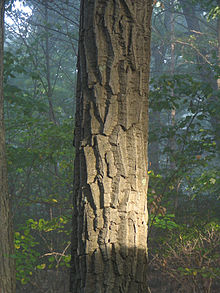Tan (color)
| Tan | |
|---|---|
| Common connotations | |
| skin color, sunbathing | |
| Hex triplet | #D2B48C |
| sRGBB (r, g, b) | (210, 180, 140) |
| HSV (h, s, v) | (34°, 33%, 82%) |
| CIELChuv (L, C, h) | (75, 39, 56°) |
| Source | X11 |
| ISCC–NBS descriptor | Grayish yellow |
| B: Normalized to [0–255] (byte) | |
| Some shades of Tan | |
| Dark Tan | |
Tan is a pale tone of brown. The name is derived from tannum (oak bark) used in the tanning of leather.[1]
The first recorded use of tan as a color name in English was in the year 1590.[2]

Colors which are similar or may be considered synonymous to tan include: tawny, tenné, and fulvous.
Variations of tan
Sandy tan
| Sandy Tan | |
|---|---|
| Hex triplet | #FDD9B5 |
| sRGBB (r, g, b) | (253, 217, 181) |
| HSV (h, s, v) | (30°, 28%, 99%) |
| CIELChuv (L, C, h) | (89, 39, 51°) |
| Source | Crayola[3] |
| ISCC–NBS descriptor | Pale orange yellow |
| B: Normalized to [0–255] (byte) | |
Displayed at right is the color Sandy tan.
This color was formulated by Crayola in 2000 as a Crayola marker color.
Tan (Crayola)
| Tan | |
|---|---|
| Hex triplet | #FAA76C |
| sRGBB (r, g, b) | (250, 167, 108) |
| HSV (h, s, v) | (25°, 57%, 98%) |
| CIELChuv (L, C, h) | (75, 79, 37°) |
| Source | Crayola |
| ISCC–NBS descriptor | Moderate orange |
| B: Normalized to [0–255] (byte) | |
Displayed at right is the orangish tone of tan called tan since 1958 in Crayola crayons and 1990 in Crayola markers.
Windsor tan
| Windsor Tan | |
|---|---|
| Hex triplet | #AE6838 |
| sRGBB (r, g, b) | (174, 104, 56) |
| HSV (h, s, v) | (24°, 68%, 68%) |
| CIELChuv (L, C, h) | (51, 66, 34°) |
| Source | ISCC-NBS |
| ISCC–NBS descriptor | Strong brown |
| B: Normalized to [0–255] (byte) | |
Displayed at right is the color Windsor tan.
The first recorded use of Windsor tan as a color name in English was in 1925.[4]
Tuscan tan
| Tuscan Tan | |
|---|---|
| Hex triplet | #A67B5B |
| sRGBB (r, g, b) | (166, 123, 91) |
| HSV (h, s, v) | (26°, 45%, 65%) |
| CIELChuv (L, C, h) | (55, 41, 41°) |
| Source | ISCC-NBS |
| ISCC–NBS descriptor | Light brown |
| B: Normalized to [0–255] (byte) | |
Displayed at right is the color Tuscan tan.
The first recorded use of Tuscan tan as a color name in English was in 1926.[5]
The normalized color coordinates for Tuscan tan are identical to café au lait and French beige, which were first recorded as color names in English in 1839[6] and 1927,[7] respectively.
In human culture
- Tan is the color of the United States Army Rangers beret as well as Canada's Canadian Special Operations Regiment and Joint Task Force 2.[8]
United States politics
- The Barack Obama tan suit controversy was an incident when US President Barack Obama wore a tan colored suit during a press conference.
See also
- Lists of colors
- Buff, a similar color
- Khaki, another similar color
- Tawny (color)
References
- ^ "tan". Online Etymology Dictionary. Retrieved 2011-09-13.
- ^ Aloys John Maerz; Morris Rea Paul (1930). A Dictionary of Color (1st ed.). New York: McGraw-Hill. p. 205.
- ^ Crayola Sandy Tan marker
- ^ Aloys John Maerz; Morris Rea Paul (1930). A Dictionary of Color (1st ed.). New York: McGraw-Hill. pp. 49, 207. Plate 13 Color Sample G12; Color Sample of Windsor Tan
- ^ Aloys John Maerz; Morris Rea Paul (1930). A Dictionary of Color (1st ed.). New York: McGraw-Hill. pp. 49, 206. Plate 13 Color Sample C8; Color Sample of Tuscan tan
- ^ Aloys John Maerz; Morris Rea Paul (1930). A Dictionary of Color (1st ed.). New York: McGraw-Hill. p. 47, 191. Plate 12 Color Sample A6; Color Sample of Cafe au Lait
- ^ Aloys John Maerz; Morris Rea Paul (1930). A Dictionary of Color (1st ed.). New York: McGraw-Hill. p. 49, 195. Plate 13 Color Sample A7; Color Sample of French beige
- ^ http://www.csor-rosc.forces.gc.ca/index-eng.asp. Archived 2013-07-02 at the Wayback Machine
